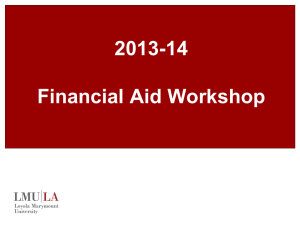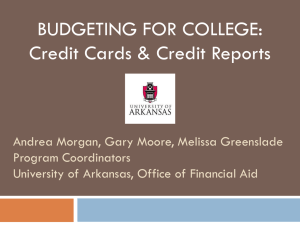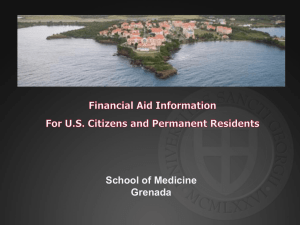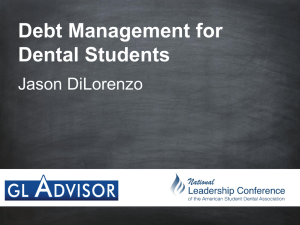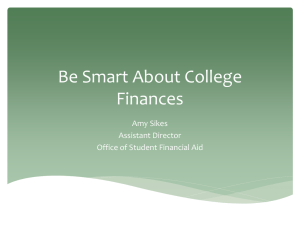College Funding For Families with a College
advertisement
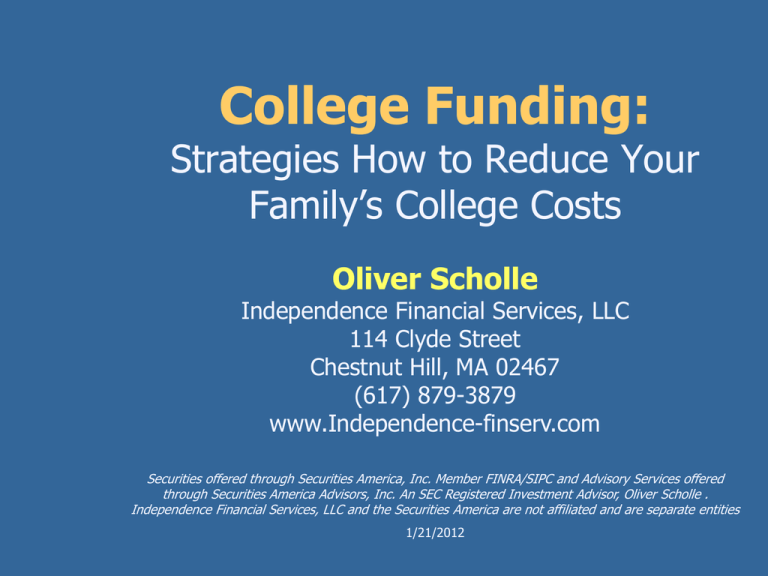
College Funding: Strategies How to Reduce Your Family’s College Costs Oliver Scholle Independence Financial Services, LLC 114 Clyde Street Chestnut Hill, MA 02467 (617) 879-3879 www.Independence-finserv.com Securities offered through Securities America, Inc. Member FINRA/SIPC and Advisory Services offered through Securities America Advisors, Inc. An SEC Registered Investment Advisor, Oliver Scholle . Independence Financial Services, LLC and the Securities America are not affiliated and are separate entities 1/21/2012 2011-2012 College Costs Average cost of 4-year public school: $20,339 per year* Average cost of 4-year private school: $40,476 per year* Includes: Tuition and fees, room & board, transportation, books & supplies and personal expenses * Based on data from The College Board, Trends in College Pricing, 2010 Cost of Attendance (COA) Four Year Private College Tuition $27,293 Room and Board $ 9,700 Books $ 1,181 Transportation $ 862 Other Expenses $ 1,440 Total Cost of Attendance $40,476 * Based on data from The College Board, Trends in College Pricing, 2010 Massachusetts Four Year Colleges COA Williams College $57,252 Tufts University $56,608 University of Massachusetts $23,656 Salem State College $20,204 * Based on data from College Board, Fall 2008, living on campus What Can Your Family Do to Reduce College Expenses? Start early Learn the rules Control the process Be Proactive Sources the Family Can Use to Pay College Needs Based Financial Aid Merit Aid Family Income* Family Assets* Private Scholarships Federal and Other Loans * Consider tax strategies to reduce college costs Need Based Financial Aid Need-based aid is tied to the parent’s and child’s income and assets. Financial Need is determined by the following formula: COA – EFC = FN COA = Cost of Attendance EFC = Expected Family Contribution FN = Financial Need Examples of Federal EFC & Financial Need FAMILY #1 FAMILY #2 In-state Out- of- State Parent Income $92,000 $140,000 Student Income $0 $0 Parent Assets $20,000 $20,000 Student Assets $10,000 $10,000 EFC (Estimated) $20,000 $40,000 FINANCIAL N EED (COA – EFC) $0 $0 *Hypothetical example for illustrative purposes only Sources of Federal Financial Aid Pell Grants – For families with significant need 5% Work Study – Offered on campus for minimum wage Perkins Loans – Student loan at 5% fixed Stafford Loans – Student loan subsidized 3.5% and unsubsidized 6.8% PLUS Loans – 7.9% fixed parent as borrower How to Apply for Financial Aid The Free Application for federal Student Aid (FAFSA) The CSS Profile College’s Own Institutional Forms Additional Forms: • Business / Farm Supplement • Non-Custodial Parent Form When To Apply for Aid The FAFSA application is available online as early as January 1st of the senior year of high school. Each college sets its own deadline listed on their website and at collegeboard.com The CSS Profile form can be filed earlier in the fall of the student’s senior year. It always pays to file as early as possible Merit Aid Private universities can allocate merit aid by their own rules often in excess of your financial need. Merit aid policies and availability differ significantly among private colleges and some do not offer any merit aid at all. Often merit aid is awarded on a first come, first served basis. Many colleges give preferential packaging to students is in the top 25% of applicants. Evaluating Merit Aid Opportunities Many colleges publish: Average % of Need Met Grants as a % of Total Undergrad. Aid Breadth of non need based aid categories Average merit aid awarded Average indebtedness at graduation Example of Merit Aid Award Example: Private College in Texas Parent’s AGI $205,000 Parent Assets $85,000 Cost of Attendance $38,500 Trustees Scholarship $12,000 Walton Loan $2,000 Stafford Loan $3,500 Parent PLUS Loan $21,000 Award Total $38,500 X4= $48,000! Actual 2008 award Examples Merit Aid Richmond New York University % Need Met 100% 69% Grants as % total aid 85% 62% Avg. Non Need Award $37,000 $7,000 Avg. Indebtedness $23,000 NR / $35,000* Non Need Categories 7 1 7 = Academics, art, athletics, leadership, minority, music/drama, ROTC 1 = Academics Source: College Board and *NYU Local.com How Can the Student Contribute Towards the Cost of Their College Education? Student Employment to Pay for College Students have many sources of employment before and during college years. • Summer jobs • Federal Work Study Program • Work off campus (incl. ROTC) • Work for a family business while in college • Work as a resident advisor while in college Private Scholarships Money provided by third parties that provide awards that you take with you to your college The student applicant chooses those private scholarships that best fit their interests and goals Offered by fraternal organizations, individuals, foundations, service groups, corporations, banks. Many are merit-based – ethnicity, field of study, hobbies, community service. Often the best opportunities are in your local community and even your high school Why Pursue Private Scholarships? They do not need to be paid back! They are available at any grade level. Many are not based on financial need or academic performance. They can be won by any type of student. College Funding with Loans Borrowing Options / Prioritization: • Perkins Loans (Student obligor) • Stafford Loans (Student obligor) • Parent Loan for Undergraduate Student (PLUS Loans) • Mass. Educational Funding Authority (MEFA.org) • Out of State Educational Authority Loans* • Home Equity Loans * When attending college outside Massachusetts consider that state’s educational funding authority compared with MEFA loans The Federal Stafford Loan Always start with federal loans when borrowing to pay for college. The Federal Stafford Loan can contribute $27,000 toward the costs of a four year education. This is the second lowest interest rate available on a federal student loan after the Perkins Loan.. Loans are now funded only by the federal government today but vary between subsidized and unsubsidized Stafford loans based on need. Using Student Loans to pay for College Stafford Loan interest rate is 6.8% pa Repayment is over 10 years after graduation Stafford Loans can have interest rate subsidies by the federal government for lower income borrowers Student applies for the Stafford Loan – not the parents Application is done on line and funds are automatically sent to the college each year up to limits Ten Strategies -How the Student Can Contribute Toward the Cost of Their College Education 1. Start planning early and talk with your parents about what they feel they can afford 2. Pick your major carefully to graduate within four years 3. Apply for private scholarships 4. Use the Stafford Loan 5. Consider a gap year if you have siblings who will overlap in college How the Student Can Contribute Toward the Cost of Their College Education cont. 6. Apply to colleges where you have a high likelihood of winning merit aid 7. Live at home for a couple of years if possible 8. Consider additional student loans from MEFA 9. Work as a resident advisor while in college 10. Find departmental or other scholarship money within the college Tax Strategies to Reduce the Family’s College Costs Tax Strategies For Affluent Families Savings Strategies and 529 Plans Education Tax Credits Compensating the child Employer Assistance Programs Section 529 Plans Tax-deferred growth from federal and state income taxes until withdrawn Then tax-free withdrawals if used for qualified higher education expenses Qualified expenses can include tuition, fees, room and board, books, and required supplies are tax-free As with other investments, there are generally fees and expenses associated with participation in a 529 savings plan. There is also the risk that the plan investments may lose money. Most states offer their own 529 programs, which may provide advantages and benefits exclusively for their residents and taxpayers. Non-qualified withdrawals may be subject to a 10% penalty. Example: 529 Plans $30,000 investment at 7% for 6 years (For illustrative purposes only) Without 529 Tax Advantage: Future Value of Investment Account * Amount Invested Taxable Amount Parents’ Tax Bracket Parents’ Tax Liability $45,022 $30,000 $15,022 x 15% $2,253 With 529 Tax Advantage: Future Value of 529 Plan Amount Invested Taxable Amount Tax Scholarship $45,022 $35,000 $0 $ 2,253 * Your results may vary based on the actual achieved investment returns. Future results may be lower or higher than those shown. 529 Plan Disclosure An investor should consider the risks, objectives, charges, and expenses associated with the 529 plan before investing. This information and more is available in the issuer's official statement, which can be obtained by contacting the plan sponsor or by contacting your financial advisor. Read it carefully before investing. An investor should also consider before investing whether the investor's or designated beneficiary's home state offers any state tax or other benefits that are only available for investments in such state's qualified tuition program. American Opportunity Tax Credit $2,500 American Opportunity Tax Credit for students attending any year of undergraduate studies for net tuition and fees, books (Good for 2010) Credit is phased out for single filers between $80,000 and $90,000 ($160K - $180K for married filing jointly) Tax Savings (over 2 years) $5,000 Compensating the Child Wages from the family business or rental Not subject to social security tax if under age 18 and paid from sole proprietorship An effective strategy for multiple years of tax savings to pay for college Child’s earned income is eligible to contribute to an IRA including a Roth. Compensating the Child (For illustrative purposes only) Business income $6,000 Parents’ Tax Bracket x 35% Parents’ Tax Liability $2,100 versus Business Income Paid as wages $6,000 Child’s Tax Rate X 10% Child’s Tax Liability $ 600 equals One Year Tax Savings $ 1,500 Compensating the Child Shifting Income Establish employer provided education assistance benefits (Benefits of up to $5,250 per year tax-free) If parent has a closely held business, child must be age 21 or older to qualify, be a legitimate employee of the business and not be a tax dependent of the parent/owner Example: Shifting Income (Education assistance plan – For illustrative purposes only) Without Educational Assistance Plan Business Income Amount $5,250 Parents’ Tax Bracket x 35% Parents’ Tax Liability $1,838 With Educational Assistance Plan Child’s Edu. Asst. Benefit Amount Child’s Tax Rate Child’s Tax Liability Tax Savings $5,250 X 0% $0 $1,838 What Parents Can Do to Reduce Their Out of Pocket College Expenses Start early – well before student’s senior year If you need financial aid avoid early decision Consider financial aid impact of repositioning assets and income Understand how tax strategies can significantly reduce college funding costs Get professional help Any tax or legal information provided here is merely a summary of our understanding and interpretation of some of the current income tax regulations and is not exhaustive. Investors must consult their tax advisor or legal counsel for advice and information concerning their particular situation. 10/2011 Conclusions Need based financial aid is complex and can require advance planning to avoid costly mistakes. Merit aid can be a major contributor towards reducing your college costs. Students have significant means available to help their parents with the cost of college Tax strategies are numerous and can also make a significant contribution towards college costs. Your Feedback Please take a couple of minutes to complete the green evaluation form and give us your honest feedback as to what you thought about this presentation THANK YOU!

